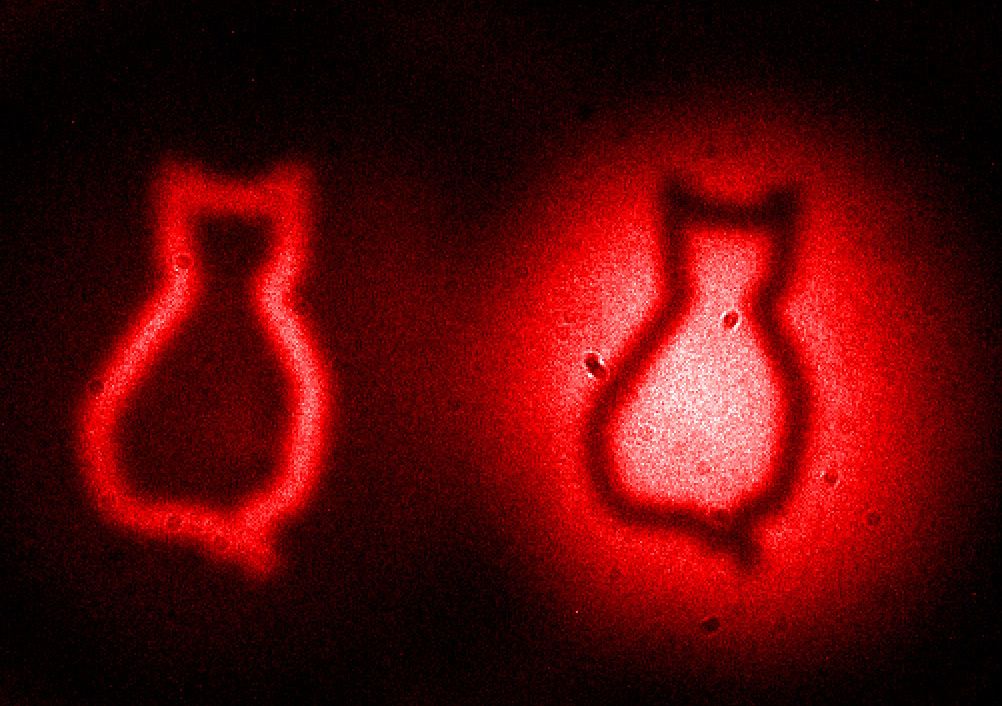Schrödinger's Cat Comes into View with Strange Physics

By sending green, red and yellow laser beams down a path to detector, researchers have shed light on the famous physics idea known as the "Schrödinger's cat" thought experiment.
For physicists, Schrödinger's cat involves picturing a cat, in a box, with a vial of poison that can kill the cat if it opens. Over any given period there's a 50-50 chance the poison vial will open, and a person who opens the box after a given time and looks at the cat will then observe that it is either dead or alive.
Most people would say that even before you open the box, before you can see the cat, it's still in either one state or the other, either dead or alive. [The 9 Biggest Unsolved Mysteries in Physics]
But according to quantum mechanics, that's not true. In this theory, until you open the box, the cat is both dead and alive, in a state called superposition. That is, the cat is in both states until you open the box and look at it, and only at that point does the state of the cat take on a certain value (dead or alive). The thought experiment has spawned numerous studies to find out, among other things, when exactly superposed states "collapse" into one.
Now, scientists at the Austrian Academy of Sciences have found a way to "look" at the cat without actually looking at it. Postdoctoral researcher Gabriela Lemos and her colleagues tested whether one could use particles of light called photons that never touch an object to see that object anyway, using an effect called entanglement.
They found that they could indeed see the cat in the box. Their findings are detailed online today (Aug. 27) in the journal Nature.
The work might also help physicists solve what they call the measurement problem, which is the question of why quantum states take on definite values only when they are observed.
Get the world’s most fascinating discoveries delivered straight to your inbox.
Entanglement happens when two particles — atoms, photons or anything else — interact in some way. For example, if two photons are entangled, then photon A will have some state that reflects the state of its entangled partner, photon B.
But you can't know the exact state of photon B by looking at photon A. Rather, photon B could still exist in any of several different states until it is looked at. However, researchers can take measurements from several entangled pairs of photons, and then check to see if their correlation — the entanglement — holds by looking at their partners.
In the new experiment, the scientists fired a laser through a series of beam splitters, ultimately to a detector. The laser they fired was a green beam, and at the first beam splitter, it was split into two green beams, one of which then went to a crystal that changed the green light into a combination of red and yellow photons. Then, the beam of red and yellow light was split into its components, with the red photons landing on a cardboard cutout of a cat while the yellow light continued on to a last beam splitter. This splitter sends half of the yellow photons to one detector, and half to another detector.
Meanwhile, the second half of the green laser beam was sent to meet up with the red beam after it passed through the cutout of the cat. The combined red and green photons hit a second crystal, which converted the green and red beam into red and yellow. This went to a beam splitter that took out the red photons, and sent this second yellow beam to meet up with the other yellow beam at the final beam splitter, which divided the photons between the two detectors.
At the detectors, the researchers saw the image of the cat. This was noteworthy because the photons that made the image had never hit the cardboard cutout. Remember, the red photons that did hit the cutout never made it to the detector, and the yellow ones that did travel to the detector never hit the cutout.
The cat image was made from the yellow photons because they were entangled with the red photons. You can't say that this yellow photon went to the first crystal and another photon went to the second — so the cat is still both dead and alive. [Twisted Physics: 7 Mind-Blowing Findings]
However, the red photons did hit the cardboard, and they were entangled with some of the yellow photons. Since we know what path they took – they hit the cutout – their states take on a definite value. The yellow photons that are entangled take on definite complementary values.
The results show that the researchers measured the entangled state of a pair of photons using only one photon of the entangled pair. In previous work, in order to see the entangled state, one had to measure both photons.
"What's most intriguing thing about this experiment is how information is contained in twin photons," Lemos told Live Science. "How, in an entangled state, [this information] can be accessed by one photon."
Follow Live Science @livescience, Facebook & Google+. Original article on Live Science.



